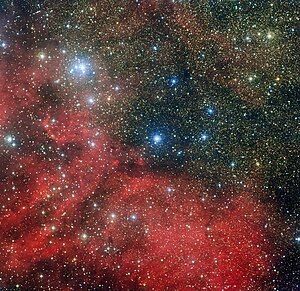NGC 6604
 | |
| Aufnahme des 2.2m ESO/MPG Teleskops. NGC 6604 ist links oben zu sehen, darunter rötlich das HII-Gebiet Sh2-54. | |
| AladinLite | |
| Sternbild | Schlange |
| Position Äquinoktium: J2000.0 | |
|---|---|
| Rektaszension | 18h 18m 02,9s [1] |
| Deklination | -12° 14′ 35″ [1] |
| Erscheinungsbild | |
| Klassifikation | I3p [2] |
| Helligkeit (visuell) | 6,5 mag [2] |
| Winkelausdehnung | 6' [2] |
| Physikalische Daten | |
| Entfernung [3] | 5500 Lj (1696 pc) |
| Geschichte | |
| Entdeckt von | William Herschel |
| Entdeckungszeit | 15. Juli 1784 |
| Katalogbezeichnungen | |
| NGC 6604 • C 1815-122 • OCl 56 • Cr 373 • GC 4398 • H VIII 15 • h 3740 • MM 23, CTB 50, NRL 17, [KPR2004b] 439, Cl Mrk 39, LMH 24, OCISM 11 | |
NGC 6604 ist ein, in das HII-Gebiet Sh2-54 eingebetteter, Offener Sternhaufen vom Trumpler-Typ I3p im Sternbild Schlange auf der Ekliptik. Er hat eine Helligkeit von 6,5 mag und einen Winkeldurchmesser von 6 Bogenminuten. Der Haufen ist rund 5.500 Lichtjahre vom Sonnensystem entfernt. Der noch relativ junge Sternhaufen ist der dichteste Bereich einer „Serpens OB“ genannten Sternassoziation, die insgesamt etwa 100 Sterne der Spektralklassen O und B enthält, unter ihnen der Blaue Überriese HD 167971.[4]
Das Objekt wurde am 15. Juli 1784 von William Herschel entdeckt.[5]
Weblinks
- ESO: Ein Sternhaufen im Sternhaufen incl. Fotos,Karte&Animationen 25. April 2012
- astronews.com: Ein oft übersehener Sternhaufen 25. April 2012
- astronews.com: Bild des Tages 10. Oktober 2013
- Spektrum.de: Amateuraufnahmen [1]
Einzelnachweise
- ↑ NASA/IPAC EXTRAGALACTIC DATABASE
- ↑ a b c SEDS: NGC 6604
- ↑ The star cluster NGC 6604 and its surroundings. In: ESO Press Release. Abgerufen am 26. April 2012.
- ↑ raumfahrer.net
- ↑ Seligman
Auf dieser Seite verwendete Medien
Autor/Urheber: ESO, Lizenz: CC BY 4.0
The star cluster NGC 6604 and its surroundings
The star cluster NGC 6604 is shown in this image taken by the Wide Field Imager attached to the 2.2-metre MPG/ESO telescope at the La Silla Observatory in Chile. NGC 6604 is the bright grouping towards to the upper left of the image. It is a young star cluster that is the densest part of a more widely scattered association containing about one hundred brilliant blue-white stars. The picture also shows the cluster’s associated nebula — a cloud of glowing hydrogen gas that is called Sh2-54 — as well as dust clouds.
Colours & filters Band Wavelength Telescope Ultraviolet U 360 nm MPG/ESO 2.2-metre telescope WFI Optical B 450 nm MPG/ESO 2.2-metre telescope WFI Optical V 540 nm MPG/ESO 2.2-metre telescope WFI Optical Rc 652 nm MPG/ESO 2.2-metre telescope WFI Optical H-alpha 656 nm MPG/ESO 2.2-metre telescope WFI
A Cluster Within a Cluster
The star cluster NGC 6604 is shown in this new image taken by the Wide Field Imager attached to the MPG/ESO 2.2-metre telescope at the La Silla Observatory in Chile. It is often overlooked in favour of its more prominent neighbour, the Eagle Nebula (also known as Messier 16), that lies a mere wingspan away. But the framing of this picture, which places the star cluster in a landscape of surrounding gas and dust clouds, shows what a beautiful object NGC 6604 is in its own right.
NGC 6604 is the bright grouping towards to the upper left of the image. It is a young star cluster that is the densest part of a more widely scattered association containing about one hundred brilliant blue-white stars [1]. The picture also shows the cluster’s associated nebula — a cloud of glowing hydrogen gas that is called Sh2-54 [2] — as well as dust clouds.
NGC 6604 lies about 5500 light-years away in the constellation of Serpens (The Serpent) and is located about two degrees north of the Eagle Nebula in the night sky (eso0926). The bright stars are easily seen in a small telescope and were first catalogued by William Herschel in 1784. However, the faint gas cloud escaped attention until the 1950s when it was catalogued by Stewart Sharpless on photographs from the National Geographic–Palomar Sky Atlas.
The cluster’s hot young stars are helping a new generation of stars to form in NGC 6604, by collecting star-making material into a compact region with their strong stellar winds and radiation. This second generation of stars will quickly replace the older generation, as although the brightest young stars are massive, they consume their fuel copiously and live short lives.
Aside from aesthetics, NGC 6604 has other reasons to draw the gaze of astronomers, as it has a strange column of hot ionised gas emanating from it. Similar columns of hot gas, which channel outflowing material from young star clusters, have been found elsewhere in the Milky Way and other spiral galaxies, but the example in NGC 6604 is relatively nearby, allowing astronomers to study it in detail.
This particular column (often referred to by astronomers as a “chimney”) is perpendicular to the galactic plane and stretches an incredible 650 light-years in length. Astronomers think that the hot stars within NGC 6604 are responsible for producing the chimney, but more research is needed to fully understand these unusual structures. Notes
[1] This stellar association is called Serpens OB. The first part of the name refers to the constellation in which it lies and the letters OB refer to the spectral type of the stars. O and B are the two hottest stellar classifications and most stars of these types are very brilliant blue-white stars, and relatively young.
[2] The name Sh2-54 means that the object is the 54th in the second Sharpless catalogue of HII regions, published in 1959.